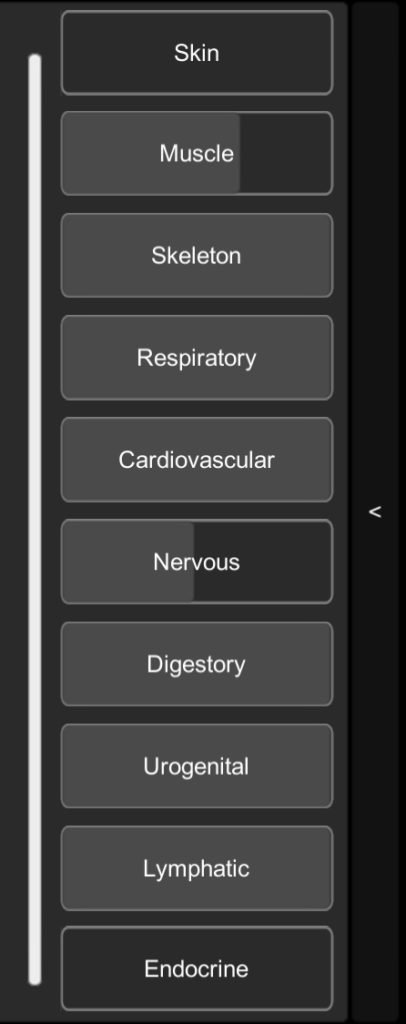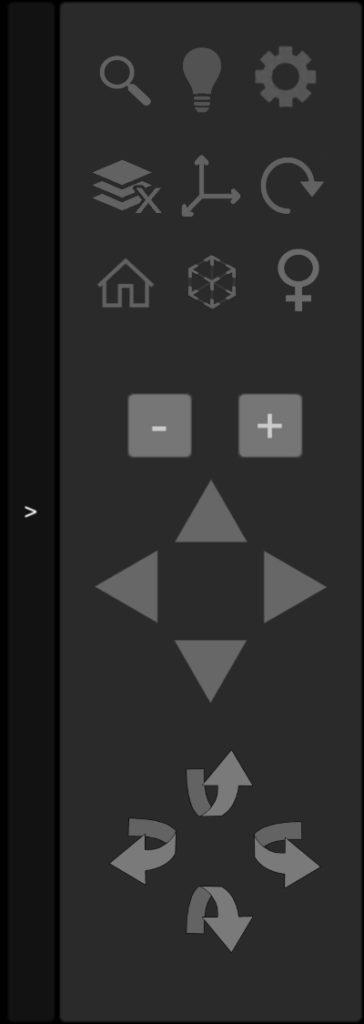- Home screen
- Main commands
- Left menu
- Right menu
- Captions
- Selecting and removing structures
- Displaying a single system
- Augmented reality
1. Home screen
Whenever you open the app, the initial screen will display the whole animal, with all systems visible. If your smartphone has a notch on the screen (area that accommodates the front camera and sensors, as shown in the image below), go to settings and activate the “notch” button to correct the left menu positioning.

2. Main commands
Allow you to browse through the interactive model:

Drag one finger → Shows structures’ captions

Drag two fingers → Rotates the model

Drag three fingers → Move the model

One quick tap with one finger → Pins the structure caption

Two quick taps with one finger → Centralizes a structure

Long tap with one finger → Select (highlights) a structure

Pinch → Zoom control

3. Left menu
The buttons on the left menu allow you to control which systems you wish to view and which should be hidden. Note that the systems have more than one layer. One click and the most superficial layer becomes semi-transparent; another click and it is completely hidden. This allows you to view deeper layers.
Each layer button also works as a bar, which allows you to gradually change the visibility of the layers. Just drag one finger from right to left over the button to see the layers gradually fade away.
The left sidebar (in white) allows you to quickly control the visibility of the layers, in a pre-defined order.
You can hide this menu by clicking on the “<” bar.
4. Right menu
The buttons on the right side of the screen allow you to perform a number of functions. Here’s how each of them works:

Search → Opens a search box. Enter the first few letters of a structure name to perform a search through all structures contained in the animal model.

Background color → Switches the background color from light to dark, making it easier to see structures such as bones and ligaments.

Configuration → Opens a settings window that allows you to change the language, text size, rotation speed and touch sensitivity. The “notch” button must be activated on smartphones with a notch on the screen (area that accommodates the front camera and sensors).

Remove all layers → Hides all the structures of the animal model.

Anatomical planes → It allows viewing the three main anatomical planes.

Auto rotation → Allow a more dynamic visualization of the model.

Home (reset) → This button makes the animal model go back to the initial settings, as it is presented at the time the app is opened.

Augmented reality → Enables the augmented reality mode. This mode works best by pointing the device’s camera at a heterogeneous surface (such as a lawn or a wooden table).

Female / Male → This button lets you switch between the female and male reproductive system.

Zoom control → Controls the size of the animal model on the screen. You can also pinch the screen with two fingers.

Move → Move the animal model to the sides, up and down. You can also drag three fingers on the screen.

Rotate → Rotates the model. You can also drag two fingers on the screen.
You can hide this menu by clicking on the “>” bar.

5. Captions
Dragging one finger over any structure will highlighted it (blue) and display a caption in your chosen language. One quick tap on the structure will pin its caption. Tap it again to hide the caption.

Note: Two quick taps on a structure will center it on the screen.
6. Selecting and removing structures
To select one or more structures, simply long tap it with one finger. The structure will be highlighted (pink).

Selected structures can be hidden by clicking the “remove” button. In this way, organs that are located deeper can be better visualized.

To once again display a hidden structure, just click the “include” button.
7. Displaying a single system
Sometimes we will want only one system to be displayed on the screen. The easiest way to do this is clicking the “remove all layers” button to hide all structures. Then select the system that you wish to be displayed by clicking on the corresponding button (left menu). In the example below, the rat nervous system was selected.

8. Augmented reality
This feature allows you to virtually insert the animal model into the real-world environment. We suggest pointing the device’s camera at a heterogeneous surface (such as a lawn or wooden table).

